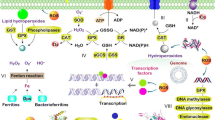Abstract
The parental strain (A+T+) of Saccharomyces cerevisiae and mutants, deficient in catalase T (A+T−), catalase A (A−T+) or both catalases (A−T−), grew on ethanol and oleic acid with comparable doubling times. Specific activities of catalase were low in glucose- and ethanol-grown cells. In the two oleic acid-grown A+-strains (A+T+ and A+T−) high catalase activities were found; catalase activity invariably remained low in the A−T+ strain and was never detected in the A−T− strain. The levels of β-oxidation enzymes in oleic acid-grown cells of the parental and all mutant strains were not significantly different. However, cytochrome C peroxidase activity had increased 8-fold in oleic acid grown A− strains (A−T+ and A−T−) compared to parental strain cells. The degree of peroxisomal proliferation was comparable among the different strains. Catalase A was shown to be located in peroxisomes. Catalase T is most probably cytosolic in nature and/or present in the periplasmic space.
Similar content being viewed by others
References
De Duve C, Baudhuin P (1966) Peroxisomes (microbodies and related particles). Physiol Rev 46:323–357
Douma AC, Veenhuis M, de Koning W, Evers M, Harder W (1985) Dihydroxyacetone synthase is localized in the peroxisomal matrix of methanol-grown Hansenula polymorpha. Arch Microbiol 143:237–243
Guiseppin MLF, van Eijk HMJ, Bos A, Verduyn C, van Dijken JP (1988) Utilization of methanol by a catalase-negative mutant of Hansenula polymorpha. Appl Microbiol Biotechnol 28:286–292
Hansen H, Roggenkamp R (1989) Functional complementation of catalase-defective peroxisomes in a methylotrophic yeast by import of the catalase A from Saccharomyces cerevisiae. Eur J Biochem 189:173–179
Kato N, Omori Y, Tani Y, Ogata K (1976) Alcohol oxidases of Kloeckera sp. and Hansenula polymorpha. Catalytic properties and subunit structures. Eur J Biochem 64:341–350
Kionka Chr, Kunau WH (1985) Inducible β-oxidation pathway in Neurospora crassa. J Bacteriol 161:153
Laemmli UK (1970) Cleavage of structural proteins during the assembly of the head of bacteriophage T4. Nature (Lond) 227:680–685
Lowry OH, Rosebrough WJ, Farr AL, Randall RJ (1951) Protein measurement with the Folin phenol reagent. J Biol Chem 193:265–275
Lück H (1963) In: Bergmeyer HU (ed) Methods of enzymatic analysis. Academic Press, New York London, pp 885–894
Skoneczny M, Chelstowska A, Rytka J (1988) Study of the coinduction by fatty acids of catalase A and acyl-CoA oxidase in standard and mutant Saccharomyces cerevisiae strains. Eur J Biochem 174:297–302
Taczyk A, Bilinski T, Litwinska J, Skoneczny M, Rytka J (1985) Calatase T deficient mutants of Saccharomyces cerevisiae. Acta Microbiol Polonica 34:231–241
Van Dijken JP, Veenhuis M, Vermeulen CA, Harder W (1975) Cytochemical localization of catalase activity in methanol-grown Hansenula polymorpha. Arch Microbiol 105:216–217
Veenhuis M, Keizer I, Harder W (1979) Characterization of peroxisomes in glucose grown Hansenula polymorpha and their development after the transfer of cells into methanol-containing media. Arch Microbiol 120:167–175
Veenhuis M, van der Klei IJ, Harder W (1986) Physiological role of microbodies in the yeast Trichosporon cutaneum during growth on ethylamine as the source of energy, carbon and nitrogen. Arch Microbiol 145:39–50
Veenhuis M, Mateblowski M, Kunau WH, Harder W (1987) Proliferation of microbodies in Saccharomyces cerevisiae. Yeast 3:77–84
Veenhuis M, Harder W (1987a) Metabolic significance and biogenesis of microbodies in yeasts. In: Fahimi HD, Sies H (eds) Peroxisomes in biology and medicine. Springer, Berlin Heidelberg New York, pp 435–457
Veenhuis M, Harder W (1987b) Microbodies in yeasts: structure, function and biogenesis. Microbiol Sci 5:347–351
Verduyn C, Giuseppin MLF, Scheffers WA, van Dijken JP (1988) Hydrogen peroxide metabolism in yeasts. Appl and Environm Microbiol 54:2086–2090
Zwart KB (1983) Metabolic significance of microbodies in the yeasts Candida utilis and Hansenula polymorpha. PhD Thesis, University of Groningen, The Netherlands
Author information
Authors and Affiliations
Rights and permissions
About this article
Cite this article
van der Klei, I.J., Rytka, J., Kunau, W.H. et al. Growth of catalase A and catalase T deficient mutant strains of Saccharomyces cerevisiae on ethanol and oleic acid. Arch. Microbiol. 153, 513–517 (1990). https://doi.org/10.1007/BF00248436
Received:
Accepted:
Issue Date:
DOI: https://doi.org/10.1007/BF00248436




